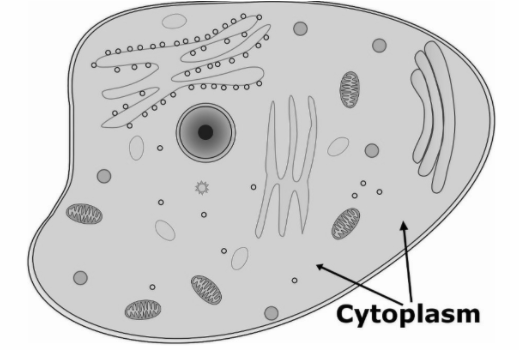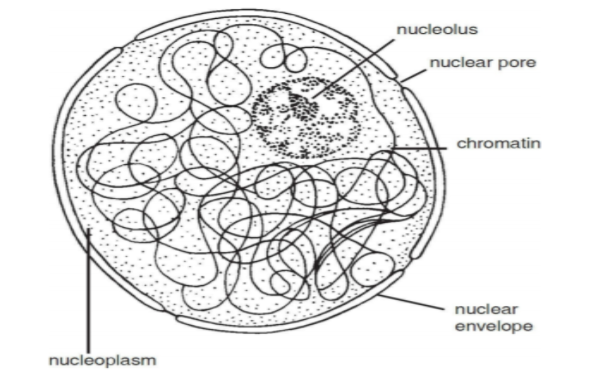
Write a short note on: Cytoplasm and Nucleus.
Answer
580.8k+ views
Hint: The cytoplasm is found in both eukaryotic and prokaryotic cells.
In prokaryotic cells, the nucleus is not covered by the nuclear membrane.
The cytoplasm cell was firstly discovered by Robert Hooke.
Complete answer:
Cytoplasm:
- It is the part of the cell which lies between the nucleus and cell membrane.
- It is a jelly-like, colourless and transparent fluid, which is externally enveloped by plasma membrane and internally enveloped by a nuclear envelope.
- It is differentiated into inner granular endoplasm and outer clearer ectoplasm.
- The cytoplasm contains $90\%$ water and $10\%$ organic compounds like lipids, carbohydrates, proteins and inorganic ions like $Na^{+}, K^{+}, Mg^{2+}, Cl^{-}, Fe^{2+}$ etc.
- The cytosol is the soluble part of the cytoplasm which forms the ground substance of the cytoplasm and is located between the cell organelles.
- The cytoplasm holds all the cell organelles as well it protects them from the damage.
- It also helps in the formation of pseudopodia in Amoeba.

Nucleus:
- The nucleus was firstly discovered by Robert Brown.
- It is the large, centrally located and double membrane bound organelle that contains the genetic material.
- Usually a single nucleus is present in each cell.
- In Prokaryotes, a well-defined nucleus is absent which means their nucleus is not enclosed by a nuclear membrane.
- In all Eukaryotes, except mature mammalian RBCs and mature sieve tubes of higher plants, the nucleus is well organised, covered by a nuclear membrane.
- The nucleus regulates all the metabolic activities of the cells as well as how they store the genetic material.
- The main components of nucleus are- nuclear membrane, nucleoplasm and nucleolus.
- The nucleus helps in synthesis of some structural proteins required for the growth of cells.

Note: The nucleus is absent in mature mammalian RBCs and mature sieve tubes of higher plants to provide more space for transportation of oxygen and nutrients respectively.
The nucleolus is also known as the factory of ribosomes because inside the nucleolus, synthesis of ribosomal RNA (rRNA) occurs. These rRNA helps in the synthesis of ribosomes and some proteins.
In prokaryotic cells, the nucleus is not covered by the nuclear membrane.
The cytoplasm cell was firstly discovered by Robert Hooke.
Complete answer:
Cytoplasm:
- It is the part of the cell which lies between the nucleus and cell membrane.
- It is a jelly-like, colourless and transparent fluid, which is externally enveloped by plasma membrane and internally enveloped by a nuclear envelope.
- It is differentiated into inner granular endoplasm and outer clearer ectoplasm.
- The cytoplasm contains $90\%$ water and $10\%$ organic compounds like lipids, carbohydrates, proteins and inorganic ions like $Na^{+}, K^{+}, Mg^{2+}, Cl^{-}, Fe^{2+}$ etc.
- The cytosol is the soluble part of the cytoplasm which forms the ground substance of the cytoplasm and is located between the cell organelles.
- The cytoplasm holds all the cell organelles as well it protects them from the damage.
- It also helps in the formation of pseudopodia in Amoeba.

Nucleus:
- The nucleus was firstly discovered by Robert Brown.
- It is the large, centrally located and double membrane bound organelle that contains the genetic material.
- Usually a single nucleus is present in each cell.
- In Prokaryotes, a well-defined nucleus is absent which means their nucleus is not enclosed by a nuclear membrane.
- In all Eukaryotes, except mature mammalian RBCs and mature sieve tubes of higher plants, the nucleus is well organised, covered by a nuclear membrane.
- The nucleus regulates all the metabolic activities of the cells as well as how they store the genetic material.
- The main components of nucleus are- nuclear membrane, nucleoplasm and nucleolus.
- The nucleus helps in synthesis of some structural proteins required for the growth of cells.

Note: The nucleus is absent in mature mammalian RBCs and mature sieve tubes of higher plants to provide more space for transportation of oxygen and nutrients respectively.
The nucleolus is also known as the factory of ribosomes because inside the nucleolus, synthesis of ribosomal RNA (rRNA) occurs. These rRNA helps in the synthesis of ribosomes and some proteins.
Recently Updated Pages
Master Class 11 Economics: Engaging Questions & Answers for Success

Master Class 11 English: Engaging Questions & Answers for Success

Master Class 11 Social Science: Engaging Questions & Answers for Success

Master Class 11 Biology: Engaging Questions & Answers for Success

Class 11 Question and Answer - Your Ultimate Solutions Guide

Master Class 11 Business Studies: Engaging Questions & Answers for Success

Trending doubts
10 examples of friction in our daily life

One Metric ton is equal to kg A 10000 B 1000 C 100 class 11 physics CBSE

Difference Between Prokaryotic Cells and Eukaryotic Cells

1 Quintal is equal to a 110 kg b 10 kg c 100kg d 1000 class 11 physics CBSE

State the laws of reflection of light

Explain zero factorial class 11 maths CBSE




